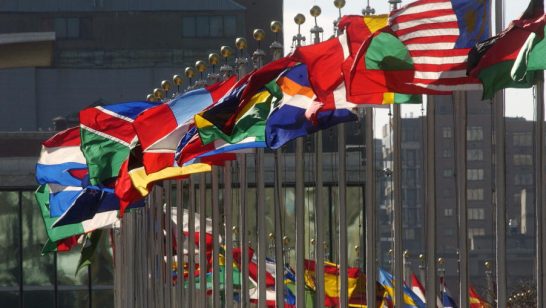
‘Rumor grows as it goes,’ according to Virgil. Rumors are particularly rampant, yet dangerous, in foreign policy, and as they grow their relative dissonance with the truth can result in costly misperceptions. A current victim of rumor is the initiative on the humanitarian impacts of nuclear weapons, which included a conference on the topic in Oslo, March 4-5, 2013. The five Nuclear Weapon States (China, France, Russia, United Kingdom, and United States, also known as the ‘P5’) chose to not attend because they believed that it would challenge the ‘step-by-step process’ towards disarmament, rooted in the Nuclear Non-Proliferation Treaty (NPT). At the same time, while the P5 may have misinterpreted rumors, the Non-Nuclear Weapon States (NNWS) also continue to misunderstand the P5. The P5 are now faced with a similar decision of whether or not to attend the follow-on conference in Mexico in February 2014. Members of the P5 have limited their options for engaging on the initiative, but the broader issue that requires attention is the growing gap between the P5 and NNWS.
There are at least three pervading rumors about the Oslo Conference which should be addressed before they grow any further. First, the rumor that it was held in conjunction with a Civil Society Forum under the auspices of the International Campaign to Abolish Nuclear Weapons (ICAN). The ICAN Forum held March 2-3 included over 400 participants from governments and civil society groups and advocated for a treaty banning nuclear weapons. This Forum was completely separate, however, from the Oslo Conference on the Humanitarian Impacts of Nuclear Weapons, which was a Norwegian government-hosted event the following two days. This confusion has tainted subsequent analysis of the initiative.
The second faulty rumor is that the goal of the initiative is to delegitimize nuclear weapons. The Conference itself was a fact-based discussion with presentations on the medical, environmental, and societal impacts of a nuclear detonation, along with response options. Participants included states with nuclear weapons (India and Pakistan), states under the U.S. nuclear umbrella (Japan), and every NATO state except for four (Bulgaria, and corresponding P5 members).
The P5 collectively chose not to attend the Oslo Conference. However, there is little public information about this decision due to the lack of transparency in the ‘P5 process,’ a series of dialogues between P5 states. What we do know, however, is from a UK statement issued on March 5 at the Conference on Disarmament: ‘We are concerned that the Oslo event will divert attention and discussion away from what has been proven to be the most effective means of reducing nuclear dangers – a practical, step by step approach that includes all those who hold nuclear weapons.’ In addition, emails released by the Foreign Office in a recent Freedom of Information Request indicate that the UK decision was based on ‘attendance [or not] of the other P5 states.’
The P5 decision to not attend may have been due to internal dynamics and prioritizing P5 unity. However, it is seemingly misinformed. Participation of NATO states and states with nuclear weapons, in particular, gave the event a sense of scope and innocuousness. While the initiative does indeed run in parallel with the NPT and the Conference on Disarmament (CD), this does not however necessitate that it challenges those forums. Even the P5 make use of such parallel initiatives; for example, the P5 engaged with India and Pakistan outside of the NPT and CD.
Unlike the first two rumors, the final rumor about Oslo may have some substance- it alleges that the humanitarian impacts initiative is another forum for NNWS to blame NWS for lack of progress on Article VI of the NPT and a commitment to ‘general and complete disarmament.’ There is a growing rift within the NPT driven by the polarization of various groupings, which are not necessarily the cause, but rather the effect of deep-seated distrust between the NNWS and P5. Due to the current stalemate in the CD, NNWS are indeed looking for other forums in which to pursue transparency and engagement with NWS and to pressure them to disarm.
What comes next for the initiative and where is it going? The Mexico Conference will likely strive to sustain momentum and therefore avoid alienating potential participants, including the P5. On April 24, the South African delegation to the NPT Preparatory Committee (PrepCom) read a statement expressing support for the initiative, which was signed by 80 states (an increase from 16 signatures to a similar statement at the 2012 PrepCom). Momentum for the initiative has therefore grown significantly and the 2014 PrepCom will likely strive to gain additional signatures, while the Mexico Conference agenda will aim to incorporate more participants and topics as a means of building a solid foundation for the initiative.
To some extent the P5 are damned if they do and damned if they do not become involved in the initiative. Given the current distrust, the NNWS are particularly prone to misinterpret any P5 decision and assume the worst. Engagement with the initiative would demonstrate P5 commitment to the consideration of the humanitarian impacts of nuclear weapons, which could increase their credibility within the NPT. From a more pragmatic perspective, if the P5 are concerned about the initiative becoming a forum of delegitimization, they would be wise to engage in these early days to steer it away from policies that go against P5 interests. Engagement would come with costs and risks, however. The Foreign Office emails also discuss the challenges of ‘limited staffing resources.’ The humanitarian impacts initiative may be a distraction not necessarily from a step-by-step process towards disarmament, but rather from other nuclear and broader policy issues requiring political capital. Ultimately, however, the P5 have limited their options by claiming the initiative would jeopardize the ‘step-by-step’ process of the NPT- it will be difficult to backtrack from this position.
Published article amended on 23 September 2013.
The opinions articulated above represent the views of the author(s), and do not necessarily reflect the position of the European Leadership Network or any of its members. The ELN’s aim is to encourage debates that will help develop Europe’s capacity to address the pressing foreign, defence, and security challenges of our time.



